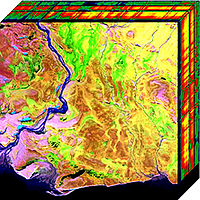
Photo from wikipedia
Compared with land surface temperature (LST) and land surface emissivity (LSE) retrieval from single-band or multispectral thermal infrared (TIR) data, TIR hyperspectral imagery allows us to obtain accurate LST and… Click to show full abstract
Compared with land surface temperature (LST) and land surface emissivity (LSE) retrieval from single-band or multispectral thermal infrared (TIR) data, TIR hyperspectral imagery allows us to obtain accurate LST and LSE through the use of an automatic temperature and emissivity separation (TES) method. However, the existing TES algorithms have rarely been investigated with airborne TIR hyperspectral imagery from the Hyper-Cam sensor, which is based on Fourier transform infrared technology. In this article, a practical LST and LSE retrieval framework incorporating reanalysis atmospheric profiles is proposed for use with Hyper-Cam airborne TIR hyperspectral imagery. In this framework, an atmospheric compensation method is introduced based on spatiotemporal analysis and the fusion of three types of widely used atmospheric profiles to replace the unattainable synchronously measured atmospheric profiles. An empirically constrained TES method is then proposed to extend the original TES algorithm to Hyper-Cam hyperspectral imagery. In addition, to exclude the negative effects of radiometric calibration error, measurement noise, and the atmospheric absorption lines in certain bands, the problematic bands are removed to improve the data quality. To evaluate the performance of the proposed framework, a set of airborne TIR hyperspectral imagery with 81 bands was acquired using the Hyper-Cam airborne system. Experiments were carried to compare the performance of the proposed method and the Fast Line-of-sight Atmospheric Analysis of Spectral Hypercubes-Infrared (FLAASH-IR) method. The results indicate that the proposed method can obtain more robust and accurate results than FLAASH-IR, and the root-mean-square error (RMSE) of the emissivity data is around 0.015 for all the validation samples.
Journal Title: IEEE Journal of Selected Topics in Applied Earth Observations and Remote Sensing
Year Published: 2022
Link to full text (if available)
Share on Social Media: Sign Up to like & get
recommendations!